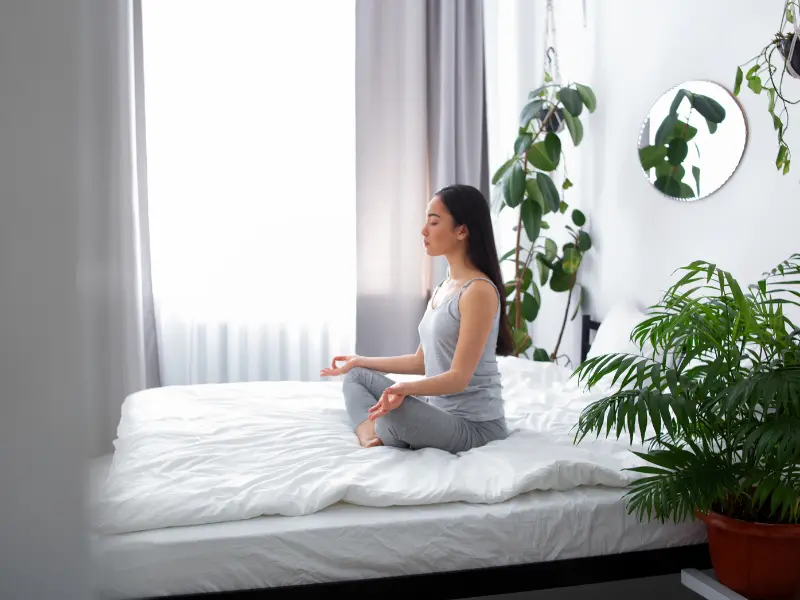Inner peace is a state of mind that many people strive for but few achieve. It is feeling calm and content with oneself, regardless of external circumstances.
Achieving inner peace can be challenging, especially in today’s fast-paced and stressful world. However, there are many ways to cultivate inner peace; anyone can achieve it with practice.
One key to finding inner peace is to focus on the present moment. Too often, we get caught up in worries about the future or regrets about the past. By staying present and mindful, we can let go of these worries and find peace in the here and now.
In this article, we will explore 23 ways to achieve inner peace. Whether you are new to the concept or have been working on it for years, there is something on this list for everyone.
Understanding the Concept of Inner Peace
Before we discuss ways to achieve inner peace, it’s important to understand what it means.
Inner peace is about feeling calm and relaxed and being in harmony. It involves acceptance, forgiveness, and compassion toward oneself and others.
Inner peace also involves letting go of attachments and expectations. We create inner turmoil when we hold onto grudges, regrets, or desires for things to be a certain way. By releasing these attachments and accepting things as they are, we can find peace within ourselves.
Achieving a peaceful mind doesn’t mean eradicating stress, anxiety, or negative emotions from our lives. Instead, it’s about learning to manage these feelings healthily. It involves maintaining balance and grounding amid the chaos and challenges life presents.
Inner peace is not achieved overnight. It is a journey that requires patience, self-awareness, and practice. It involves developing a deeper understanding of oneself and the world and finding a way to live harmoniously with both.
Ultimately, achieving inner peace is about finding balance. It is about prioritizing what is truly important and letting go of things that do not serve us. It is about cultivating gratitude and compassion and living harmoniously with ourselves and the world.
Inner Peace and Mental Health
Inner peace is essential for good mental health. It helps us manage stress, anxiety, and depression. When we remain calm, we can better cope with life’s challenges.
A meta-study researched forty-five studies and revealed that all forms of meditation can drastically reduce systolic blood pressure and other markers related to stress. Focused attention meditations also have the added benefit of reducing heart rate while lowering cortisol levels.
Further research found a collective decrease in cortisol, C-reactive protein, blood pressure, heart rate triglycerides, and tumor necrosis factor-alpha when analyzing all meditations together*.
Incorporating meditation into your daily life can have an immensely positive impact on managing your physical and mental well-being.
Finding Your Inner Calm
Inner peace is not an end goal; it is a continuous journey. Here are 23 ways to cultivate inner peace in your daily life.
Mindset:

#1 Be Grateful
Practicing gratitude can transform your perspective, shifting your focus from what’s going wrong to the positives in your life. Dedicate a few minutes each day to reflect on what you’re thankful for. Whether you maintain a gratitude journal or simply note in your mind the things that bring you joy and happiness, making this practice a habit can foster a more positive mindset.
#2 Let Go
Letting go of negative emotions and thoughts can be difficult, but it’s essential for finding inner peace. Holding onto anger, resentment, or other negative emotions can create stress and anxiety.
Try practicing mindfulness meditation or deep breathing exercises to help you let go of negative thoughts and emotions.
#3 Forgive
Forgiving yourself and others can be a powerful tool for finding peace of mind. Cultivating a forgiving attitude has emotional benefits and can improve your physical health.
Practice forgiveness meditation or write a letter of forgiveness to someone who has hurt you. Remember that forgiveness is a process, and it may take time.
#4 Practice Acceptance
Accepting yourself for who you are, flaws and all, can be challenging but rewarding. It’s important to recognize that we all have strengths and weaknesses and that it’s okay to make mistakes. Try practicing self-acceptance and reminding yourself that you’re doing your best.
Quieting Your Thoughts:

#5 Meditate
Meditation has been used for centuries to help achieve inner peace.
To practice meditation, find a comfortable place to sit or lie down and close your eyes. Focus on your breath and let go of any negative emotions or thoughts.
There are many different types of meditation, so explore and find what works best for you.
#6 Practice Mindfulness
In everyday life, we are constantly bustling with thoughts and worries that cloud our minds.
Mindfulness meditation has emerged as a popular and effective technique to soothe the turmoil of our inner voice. It requires anchoring one’s attention to the present moment without prejudices or distractions.
To begin, find a comfortable and secluded spot where you can unwind. Take a few deep breaths and close your eyes, relaxing your senses. Then, focus on the sensation of your breath entering and exiting through your nose. Observe the rise and fall of your chest or abdomen with each inhalation and exhalation. When a stray thought captures your mind, acknowledge it and gently guide your thoughts back to your breath.
Through consistent practice, your mind will be restored to tranquility, and you will experience inner peace and calmness.
Incorporate mindfulness into your daily routine by staying present and concentrating on each task, whether brushing your teeth or preparing a meal.
#7 Practice Breathing Techniques
Breathing techniques can also help you to achieve inner peace. One popular technique is deep breathing.
Take a few moments to sit or recline in peace and let your attention settle on the breath. Inhale deeply through your nose, filling each corner of your lungs with air. Pause for a moment before slowly exhaling out of your mouth. Repeat this process several times while concentrating only on breathing and allowing any tension or stress to drift away.
#8 Visualize
Visualization is a powerful meditation technique that can help you to achieve inner peace.
To practice visualization, find a quiet place to sit or lie down. Take a moment to visualize a serene location, like the beach or an enchanted forest. Close your eyes and drift away into this tranquil setting. Visualize yourself in this scene, feeling calm and relaxed. Focus on the scene’s details and immerse yourself in it.
#9 Use a Mantra
Mantras are repeated phrases or words that can help you to achieve inner peace. To practice mantra meditation, find a quiet place to sit or lie down. Choose a word or phrase with a personal meaning, such as “peace” or “love.” Close your eyes and repeat the word or phrase silently to yourself, focusing on its meaning and letting go of any distracting thoughts.
Self-Care:

#10 Exercise
Making physical activity a regular habit can effectively reduce tension, enhance one’s state of mind, and promote overall health. Find an activity you enjoy, such as running or swimming, and aim to do it at least a few times a week.
#11 Do Yoga
Yoga is an ancient practice that combines physical, mental, and spiritual practices. The physical postures can help improve flexibility and strength, while the breathing exercises and meditation practice can cultivate inner peace. Regularly practicing yoga can also improve your physical health.
#12 Eat Healthy
A balanced, nutritious diet can help support your physical and mental health. Focus on incorporating plenty of fruits, vegetables, whole grains, and lean protein into your meals. Avoid processed foods, excessive sugar, and caffeine, which can contribute to feelings of anxiety and stress.
#13 Sleep Well
Getting enough sleep is crucial for maintaining good health and well-being. For optimal health and wellness, striving for 7-9 hours of sleep each night is best. Developing a consistent bedtime routine can also help promote deeper restorative sleep that will energize you. Avoid screens and stimulating activities before bed, and create a peaceful sleep environment that promotes relaxation.
#14 Embrace Self-Compassion
Supporting yourself with kindness, understanding, and acceptance is essential to cultivating self-compassion. Be gentle with yourself when facing challenges or setbacks, and avoid harsh self-criticism. Cultivate a positive inner dialogue that focuses on self-love and acceptance.
#15 Enjoy Life
Remember to take time for activities that bring you joy. Whether it’s spending time with loved ones, pursuing a hobby, or simply relaxing and enjoying nature, make time for the things that make you happy. Prioritizing enjoyment and relaxation can help reduce stress and promote inner peace.
Connection:

#16 Spend Time in Nature
Spending time in nature can help you feel more connected to the world. Visit the park or go for a hike in the woods. Sit by the ocean or a river and listen to the sounds of nature. Plant a garden or take care of houseplants.
#17 Get a Pet
Pets can provide companionship and unconditional love. Adopting a pet from your local shelter or rescue organization can also decrease stress and anxiety. If you can’t have a pet, consider volunteering at an animal shelter or pet-sitting for a friend.
#18 Reach Out
Feeling lonely? Connect with others by joining a group or organization. You’ll discover like-minded people and experience the comfort of support. Attend social events or parties. Volunteer for a cause you care about. Call or text a friend or family member to catch up.
#19 Unite For World Peace
Feeling connected to the world and working towards peace can also help you find inner peace. Consider volunteering for a peace organization or donating to a charity that supports peace efforts. Attend a peace rally or march. Educate yourself on global issues and how you can make a positive impact.
Reflection:

#20 Journal
Journaling can be a powerful way to reflect on your life and find inner peace. Writing down your own thoughts and feelings can help you identify patterns of behavior, recognize triggers that cause you stress or anxiety, and gain clarity on your emotions.
Set aside time each day to write in a journal and be as honest and open as possible. Don’t worry about grammar or spelling; just let your thoughts flow onto the page.
#21 Admit your mistakes
Admitting mistakes can be difficult but essential to finding inner peace. When you take responsibility for your actions, you free yourself from the burden of guilt and shame. It can be helpful to reflect on your past mistakes and consider how you can learn from them. Apologize to anyone you may have hurt and forgive yourself for your past mistakes. Everyone makes mistakes, and it’s never too late to make amends.
#22 Connect with a Therapist
Therapy can be a valuable tool for finding inner peace. A therapist can help you identify the root causes of your stress and anxiety and provide you with coping mechanisms to manage them. They can also help you work through past traumas or unresolved emotional issues. If you’re feeling overwhelmed or struggling to find peace alone, consider contacting a licensed therapist for support.
#23 Nurture Your Soul
For many, spirituality can be a source of comfort and inner peace. Whether you find solace in religion, meditation, or nature, connecting with something greater than yourself can help put your problems into perspective. Explore your spiritual beliefs and practices, and find what resonates with you. Remember that spirituality is a personal journey, and there’s no right or wrong way to find inner peace.
Conclusion
Finding inner peace is a lifelong journey. Learning how to manage stress, connect with others, forgive yourself, and find meaning in life takes time and effort. But it’s worth it—it can help you lead a more peaceful and fulfilled life. So take some time for yourself, explore the world, reach out to others, and be gentle with yourself. With patience and practice, you can find your inner peace.
References:
*Mindfulness mediates the physiological markers of stress: Systematic review and meta-analysis. Michaela C Pascoe et al.

